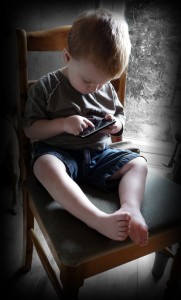A Is for App: How Smartphones, Handheld Computers Sparked an Educational Revolution
By: Anya Kamenetz –
Gemma and Eliana Singer are big iPhone fans. They love to explore the latest games, flip through photos, and watch YouTube videos while waiting at a restaurant, having their hair done, or between ballet and French lessons. But the Manhattan twins don’t yet have their own phones, which is good, since they probably wouldn’t be able to manage the monthly data plan: In November, they turned 3.
When the Singer sisters were just 6 months old, they already preferred cell phones to almost any other toy, recalls their mom, Fiona Aboud Singer: “They loved to push the buttons and see it light up.” The girls knew most of the alphabet by 18 months and are now starting to read, partly thanks to an iPhone app called First Words, which lets them move tiles along the screen to spell c-o-w and d-o-g. They sing along with the Old MacDonald app too, where they can move a bug-eyed cartoon sheep or rooster inside a corral, and they borrow Mom’s tablet computer and photo-editing software for a 21st-century version of finger painting. “They just don’t have that barrier that technology is hard or that they can’t figure it out,” Singer says.
Gemma and Eliana belong to a generation that has never known a world without ubiquitous handheld and networked technology. American children now spend 7.5 hours a day absorbing and creating media — as much time as they spend in school. Even more remarkably, they multitask across screens to cram 11 hours of content into those 7.5 hours. More and more of these activities are happening on smartphones equipped with audio, video, SMS, and hundreds of thousands of apps.
The new connectedness isn’t just for the rich. Mobile adoption is happening faster worldwide than that of color TV a half-century ago. Mobile-phone subscribers are expected to hit 5 billion during 2010; more than 2 billion of those live in developing countries, with the fastest growth in Africa. Mobile broadband is forecast to top access from desktop computers within five years.
As with television, many people are wondering about the new technology’s effect on children. “The TV set was pretty much a damned medium back in the ’60s,” says Gary Knell, CEO of Sesame Workshop. But where others railed against the “vast wasteland,” Sesame Street founders Joan Ganz Cooney and Lloyd Morrisett saw a new kind of teacher. “They said, Why don’t we use it to teach kids letters and numbers and get them ready for school?” Sesame Street, from its 1969 debut, changed the prevailing mind-set about a new technology’s potential. With its diverse cast and stoop-side urban setting, the show was aimed especially at giving poor kids a head start on education.
Today, handheld and networked devices are at the same turning point, with an important difference: They are tools for expression and connection, not just passive absorption. “You put a kid in front of a TV, they veg out,” says Andrew Shalit, creator of the First Words app and father of a toddler son. “With an iPhone app, the opposite is true. They’re figuring out puzzles, moving things around using fine motor skills. What we try to do with the game is create a very simple universe with simple rules that kids can explore.”
For children born in the past decade, the transformative potential of these new universes is just beginning to be felt. New studies and pilot projects show smartphones can actually make kids smarter. And as the search intensifies for technological solutions to the nation’s and the world’s education woes — “Breakthrough Learning in a Digital Age,” as the title of a summit at Google HQ last fall had it — growing sums of money are flowing into the sector. The U.S. Department of Education has earmarked $5 billion in competitive school-reform grants to scale up pilot programs and evaluate best practices of all kinds. Major foundations are specifically zeroing in on handhelds for preschool and the primary grades. “Young kids and multisensor-touch computing are a huge area of innovation,” says Phoenix Wang, the head of a startup philanthropic venture fund called Startl — funded by the Gates, MacArthur, and Hewlett foundations — that’s entirely focused on educational investing. Google, Nokia, Palm, and Sony have all supplied handheld devices for teaching. Thousands of new mobiles — not just smartphones but also ever-shrinking computers — have come into use at schools in the United States and around the world just in the past year.


Leave a Reply
You must be logged in to post a comment.